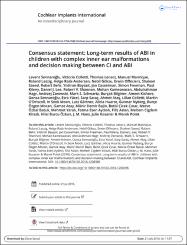| dc.contributor.author | Sennaroğlu, Levent | |
| dc.contributor.author | Colletti, Vittorio | |
| dc.contributor.author | Lenarz, Thomas | |
| dc.contributor.author | Manrique, Manuel | |
| dc.contributor.author | Laszig, Roland | |
| dc.contributor.author | Rask Andersen, Helge | |
| dc.contributor.author | Göksu, Nebil | |
| dc.contributor.author | Offeciers, Erwin | |
| dc.contributor.author | Saeed, Shakeel Riaz | |
| dc.contributor.author | Behr, Robert | |
| dc.contributor.author | Bayazıt, Yıldırım Ahmet | |
| dc.contributor.author | Casselman, Jan Walther | |
| dc.contributor.author | Freeman, Simon | |
| dc.contributor.author | Kileny, Paul | |
| dc.contributor.author | Lee, Daniel | |
| dc.contributor.author | Shannon, Robert | |
| dc.contributor.author | Kameswaran, Mohan | |
| dc.contributor.author | Hagr, Abdulrahman Abdullah | |
| dc.contributor.author | Zarowski, Andrzej | |
| dc.contributor.author | Schwartz, Mark | |
| dc.contributor.author | Bilginer, Burçak | |
| dc.contributor.author | Kishore, Ameet | |
| dc.contributor.author | Sennaroğlu, Gonca | |
| dc.contributor.author | Yücel Ersoy, Esra | |
| dc.contributor.author | Saraç, Sarp | |
| dc.contributor.author | Ataş, Ahmet | |
| dc.contributor.author | Colletti, Liliana | |
| dc.contributor.author | O’Driscoll, Martin | |
| dc.contributor.author | Moon, In Seok | |
| dc.contributor.author | Gartner, Lutz | |
| dc.contributor.author | Huarte, Alicia | |
| dc.contributor.author | Nyberg, Gunnar | |
| dc.contributor.author | Mocan Özgen, Burçe | |
| dc.contributor.author | Atay, Gamze | |
| dc.contributor.author | Bajini, Münir Demir | |
| dc.contributor.author | Çınar, Betül Çiçek | |
| dc.contributor.author | Batuk Özbal, Merve | |
| dc.contributor.author | Yaralı, Mehmet | |
| dc.contributor.author | Aydınlı Esen, Fatma | |
| dc.contributor.author | Aslan, Filiz | |
| dc.contributor.author | Kirazlı, Meltem Çiğdem | |
| dc.contributor.author | Özkan, Hilal Burcu | |
| dc.contributor.author | Hans, J. M. | |
| dc.contributor.author | Koşaner, Julie | |
| dc.contributor.author | Polak, Marek | |
| dc.date.accessioned | 10.07.201910:49:13 | |
| dc.date.accessioned | 2019-07-10T19:36:21Z | |
| dc.date.available | 10.07.201910:49:14 | |
| dc.date.available | 2019-07-10T19:36:21Z | |
| dc.date.issued | 2016 | en_US |
| dc.identifier.citation | Sennaroğlu, L., Colletti, V., Lenarz, T., Manrique, M., Laszig, R., Rask Andersen, H. ... Polak, M. (2016). Consensus statement: Long-term results of ABI in children with complex inner ear malformations and decision making between CI and ABI. Cochlear Implants International, 17(4), 163-171. https://dx.doi.org/10.1080/14670100.2016.1208396 | en_US |
| dc.identifier.issn | 1467-0100 | |
| dc.identifier.uri | https://hdl.handle.net/20.500.12511/1137 | |
| dc.identifier.uri | https://dx.doi.org/10.1080/14670100.2016.1208396 | |
| dc.description | 7th IEEE Asia-Pacific Conference on Applied Electromagnetics, APACE 2016 -- 11 December 2016 through 13 December 2016 -- 127632 | en_US |
| dc.description.abstract | ‘Second Consensus Meeting on Management of Complex Inner Ear Malformations: Long Term Results of ABI in Children and Decision Making Between CI and ABI’ took place on 5–6 April 2013 in Kyrenia, Northern Cyprus with the participation of 20 centers from 11 countries. These centers presented their auditory brainstem implantation (ABI) experience in children and infants and also provided the selection criteria and cochlear implant (CI) results in patients with an abnormal cochlea and nerve. In addition, Cochlear and Med El companies provided presentations regarding solutions to problems during revision surgery and future projections of device technology. According to the results from different centers, it was evident that an ABI is capable of providing hearing sensation in prelingually deafened children with complex inner ear malformations and diseases. It is possible to obtain a pure tone average with an ABI between 30 and 60 dB HL in most of these patients. It has been observed that the majority of children obtain Categories of Auditory Performance (CAP) scores around 5, but occasionally certain ABI users obtained scores of up to CAP 8-II, NEAP-Nottingham Early Assessment Package. The Ear Foundation 2009). CAP scores tend to increase with earlier implantation, i.e. under 2 years of age. However, after 3 years of use, it usually reaches a plateau. Children with additional disorders cannot reach CAP scores of children without disorders. However, they obtain an improvement of cognitive functions but duration of ABI use and increasing chronological age also play a role in this improvement. | en_US |
| dc.language.iso | eng | en_US |
| dc.publisher | Taylor and Francis Ltd. | en_US |
| dc.rights | info:eu-repo/semantics/openAccess | en_US |
| dc.subject | Consensus Statement | en_US |
| dc.subject | Long-Term Results | en_US |
| dc.subject | ABI | en_US |
| dc.subject | Children With Complex | en_US |
| dc.subject | Malformations and Decision | en_US |
| dc.subject | CI and ABI | en_US |
| dc.title | Consensus statement: Long-term results of ABI in children with complex inner ear malformations and decision making between CI and ABI | en_US |
| dc.type | article | en_US |
| dc.relation.ispartof | Cochlear Implants International | en_US |
| dc.department | İstanbul Medipol Üniversitesi, Tıp Fakültesi, Cerrahi Tıp Bilimleri Bölümü, Kulak Burun Boğaz Hastalıkları Ana Bilim Dalı | en_US |
| dc.identifier.volume | 17 | en_US |
| dc.identifier.issue | 4 | en_US |
| dc.identifier.startpage | 163 | en_US |
| dc.identifier.endpage | 171 | en_US |
| dc.relation.publicationcategory | Makale - Uluslararası Hakemli Dergi - Kurum Öğretim Elemanı | en_US |
| dc.identifier.doi | 10.1080/14670100.2016.1208396 | en_US |
| dc.identifier.scopusquality | Q2 | en_US |


















